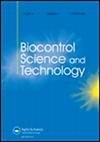Toxicity of herbicides used for control of waterhyacinth in the California Delta towards the planthopper Megamelus scutellaris released for biological control
IF 1.2
4区 农林科学
Q4 BIOTECHNOLOGY & APPLIED MICROBIOLOGY
引用次数: 0
Abstract
ABSTRACT The water hyacinth planthopper Megamelus scutellaris has been released for biological control of waterhyacinth (Eichhornia crassipes or Pontederia crassipes) in Florida and is widely established there, with additional releases in Louisiana and California, USA, and in South Africa. Management still often requires the use of herbicides. Knowledge of their direct toxicity to M. scutellaris would aid in integrated management. We tested the contact toxicity of 2,4-D, diquat, glyphosate, imazamox and penoxsulam as well as a paraffinic oil-based and a vegetable oil-based adjuvant, by exposing planthoppers to dipped leaves in the laboratory, and by applying chemicals to infested mesocosms in the field. Exposure to 2,4-D, glyphosate, imazamox and penoxsulam did not cause significant mortality to M. scutellaris compared to exposure to water-dipped leaves in the laboratory, and did not consistently reduce final counts of M. scutellaris compared to counts in water-sprayed mesocosms in field trials. Laboratory exposure to diquat-dipped leaves caused significantly (45%–69%) higher mortality than did exposure to water-dipped leaves, and exposure to leaves dipped in paraffinic-oil based adjuvant also increased mortality (40–50%). In field mesocosms, application of diquat reduced recovery of live M. scutellaris by 64% in one trial, and the same adjuvant reduced recovery by 36%–49% in two trials. The results suggest that biological and chemical control of water hyacinth using M. scutellaris can be safely integrated using most of the herbicides applied for control of this weed in California.加州三角洲水葫芦防治除草剂对褐飞虱生物防治的毒性研究
为了防治水葫芦(Eichhornia crassipes或Pontederia crassipes),美国佛罗里达州已放生水葫芦飞虱(Megamelus scutellaris),在该州广泛分布,美国路易斯安那州、加利福尼亚州和南非也有放生。管理仍然经常需要使用除草剂。了解其对黄芩的直接毒性有助于综合治理。我们测试了2,4- d、diquat、草甘膦、imazamox和penoxsulam以及石蜡油和植物油为基础的佐剂的接触毒性,方法是在实验室中将飞虱暴露在浸过的叶子上,并在田间对受感染的中介体施用化学物质。暴露于2,4- d、草甘膦、imazamox和penoxsulam与暴露于实验室中浸水的叶子相比,没有引起黄芪的显著死亡率,并且与田间试验中喷洒水的中叶草相比,黄芪的最终计数并没有一致地减少。实验室暴露于浸渍叶片的死亡率显著(45%-69%)高于浸渍叶片,暴露于浸渍石蜡油佐剂的叶片也增加了死亡率(40-50%)。在田间中观试验中,使用diquat使活黄芩的回收率降低了64%,在两项试验中,相同的佐剂使黄芩的回收率降低了36%-49%。结果表明,在加州,黄芩对水葫芦的生物和化学防治可以安全地结合使用大部分用于水葫芦防治的除草剂。
本文章由计算机程序翻译,如有差异,请以英文原文为准。
求助全文
约1分钟内获得全文
求助全文
来源期刊
CiteScore
3.20
自引率
7.10%
发文量
64
审稿时长
4-8 weeks
期刊介绍:
Biocontrol Science and Technology presents original research and reviews in the fields of biological pest, disease and weed control. The journal covers the following areas:
Animal pest control by natural enemies
Biocontrol of plant diseases
Weed biocontrol
''Classical'' biocontrol
Augmentative releases of natural enemies
Quality control of beneficial organisms
Microbial pesticides
Properties of biocontrol agents, modes of actions and methods of application
Physiology and behaviour of biocontrol agents and their interaction with hosts
Pest and natural enemy dynamics, and simulation modelling
Genetic improvement of natural enemies including genetic manipulation
Natural enemy production, formulation, distribution and release methods
Environmental impact studies
Releases of selected and/or genetically manipulated organisms
Safety testing
The role of biocontrol methods in integrated crop protection
Conservation and enhancement of natural enemy populations
Effects of pesticides on biocontrol organisms
Biocontrol legislation and policy, registration and commercialization.

 求助内容:
求助内容: 应助结果提醒方式:
应助结果提醒方式:


